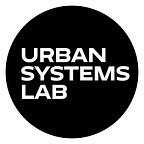The City is a Material Bank
By Johanna Hoffman
Given the explosive pace and scale of current change — from economic inequality and geopolitical instability, to technological acceleration and environmental collapse — one of the most important questions we can ask is what makes for more resilient cities. Yet responding to the impacts of widespread disease, forced migration, drought, hurricanes, floods and firestorms demands more than better power grids. It calls for stronger social ties between the people that call a city home. Research has shown that when the unexpected strikes, we cooperate better and act quicker when we foster strong connections with the humans who share our landscapes. But how to actually do so? Where do we start?
Speculative futures — stories and experiences that invite us to proactively explore what our futures might become — are among the most powerful tools we have to cultivate those ties. To face and plan for what the future can bring, people need high resolution, well researched, relatable visions of what could be. Speculative futures help us embrace the uncertainties of our current times, investigate how coming changes could impact our daily lives, and augment our abilities to adapt in response.
The City is a Material Bank, is an exploration of one such speculative future. A research based vision of urban life in 50 years, it investigates what a city might become if it embraced aspects of the circular economy, an economic system aimed at eliminating waste and the continual re-use of resources. While many researchers and leading foundations advocate for its economic and social opportunities, the circular economy has yet to take wider hold. The City is a Material Bank presents a narrative experience where the shift has already taken place, asking viewers to reflect on what it took to make such changes and what the impacts on urban space and daily life could be as a result.
The resulting piece is a voice-over video short, with the story of 2070 superimposed over aerial images of today’s urban landscapes, inviting people to envision what could be made from the reality of what is. Excerpts of the narrative are included below the short.
We zoom in on a material bank in the western sector of a city on the edge of the sea. It’s a storefront on a back alley, stories of offices and apartments rising above and keeping the sunlight low on the street where you’re waiting to go inside…
The year is 2070, half a century since a chain of pandemics hit the globe. There was coronavirus, a return of norovirus that mutated into something new, and on and on until people started to forget the names because they didn’t want to remember….
All materials these days are made with DNA embedded inside. Printed on synthetic strands constructed through chemical processes and converted from binary to DNA code, they mark each piece of the city with an identifier to track it over the course of its life…
The things that have shaped it — the person who formed it first, the material it merged with last, the arguments that happened to the people who used to live alongside it — all that is stored in its DNA. Plug in and you can listen to these histories, to the all the things that came before, to all the things that are programmed to be….
Connecting to these histories, the way the materials have been repurposed and changed over time, has made you see your city in a different way. Like most people you know, you adhere to the idea of ‘designing to disappear,’ to the idea that cities are made to grow and change over time, that what you make of the spaces you call home are part of a bigger, longer story….
Johanna Hoffman is a designer and urbanist working in the space between design, planning, fiction and futures. She is the founder of Shiftworks, a studio that uses interactive storytelling and speculative design to survey the impacts of future environments and technologies and spur proactive adaptation to climate change. She is also a practicing urban designer and futurist, implementing foresight, futures research and strategy to help clients understand what future changes mean for them, and develop actionable plans in response. Her work envisions tomorrow’s worlds to help communities, organizations and governments co-create adaptive futures where all can thrive.
